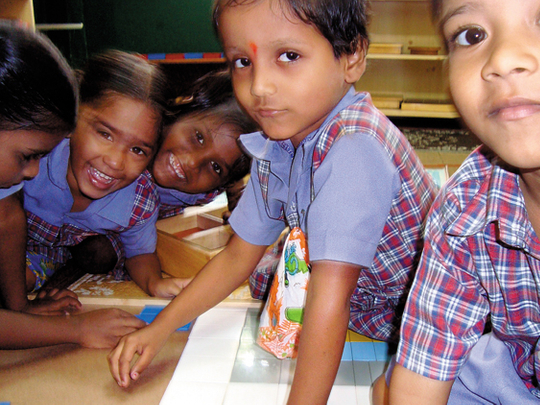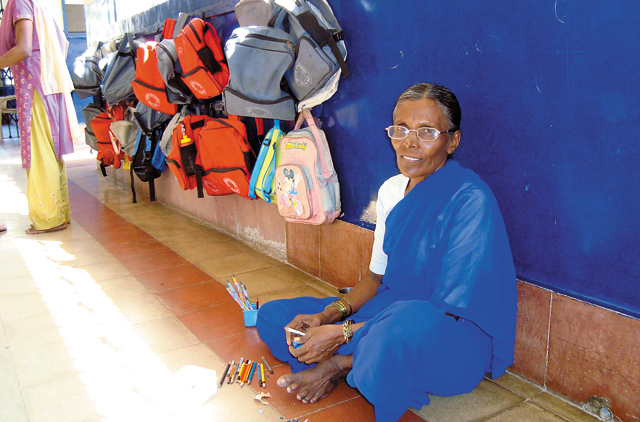
"Good morning!"Two high-pitched teenage voices, not yet broken in, greet us as we enter the BMC school building and are pleasantly surprised at the confidence of the smartly turned out kids.The inconvenience of the taxi ride is soon forgotten as we take in our surroundings. The staircase that leads up to the first floor is blocked by an iron gate and we wait till a helper opens it for us. As we step in, a wave of eager voices washes over us.
‘Hello teacher,' the chorus says to my companion, Kadkhodayan, who has suggested I visit Aseema, a school for underprivileged (a euphemism for slum) children, in Bandra, Mumbai, run by an NGO.
While doing her Montessori course for pre-primary students (so she could help her Scottish born one-year-old grandson Darian), Kathkhodayan was advised by the director to do her training sessions at Aseema (in Hindi it means ‘without limit'). Since the place was out of the way and not very known, she reluctantly signed up rueing the fact that she had to give up the opportunity to visit exclusive south Mumbai schools instead. But once she started her training, she was awed by the work the volunteers, helpers and staff of Aseema were accomplishing. At her behest, I was now accompanying her to see the magic at work first-hand.
Effective Montessori teaching
One floor of the royal blue-and-beige building of the Santacruz Municipal School has been allotted to Aseema in a partnership agreement with MCGM (the Municipal Corporation of Greater Mumbai) and the economy of space has led to interesting innovations on the part of the staff.
Every room of the pre-primary school is bright and cheerful and has a distinct lemon yellow and green carefully hand-drawn label indicating the grade of the class. The washrooms are clean and well-aired. The corridor space is used effectively and it is difficult to believe there are almost 90 odd children who attend the first shift.
Within the first hour I am there, I see 4- to 5-year-olds bring out educational material, set it up and begin doing their work. There is no ‘teacher' telling them what to do and yet, without any apparent confusion, each one is doing something different.
An adult, along with a helper, keeps a close watch over each batch of about 30 children and steps in to adjust the apparatus if the child is at a loss as to what to do next. "This is the Montessori Method and it is very effective," says Nirmala Rao the Education Officer who gave up a secure, glamorous job at a travel agency and took up relevant courses before she joined Aseema.
"We are here only to assist the child rather than give regular classroom-like instructions."
Seeing that a visitor with a camera has arrived in their classrooms, some of the children come across wanting to pose for pictures. The photos taken, the helpers, speaking to them in English, lead them back to their respective classrooms. Intrigued, I follow a few students and as I am about to enter a classroom I am requested to ‘Please take off your shoes before you enter.' I can clearly understand the intention behind Rao's request.
The educational material, much of which has been donated, is stacked neatly along the walls. The children walk up and pick what they want, spread a mat on the floor, put the material on it and begin work. Some of them work in pairs.
"The children progress at their own pace and once they have learned how to use the apparatus (which teaches them a specific educational skill), they attempt something else. At first it is a bit confusing for the child to be asked to do something he does not fully comprehend. But that's where the role of the ‘teacher' comes in. We are here to guide them and understand why they are doing what they are doing," says Rao.
After a couple of hours of observing how the system works, I can see a pattern emerging.
Mid-day meals
Come lunch time, the children emerge in batches forming a single file and walk along on a 2x2 mat spread in the corridor, stand in line to serve themselves a lunch of chick pea curry and rotis (Indian flat bread). Then they sit down and proceed to eat in relative silence. There are no instructions issued, no confusion about who will be served first or last.
At 11:30, the chairperson and founder of Aseema, Dilbur Parakh, walks in and a palpable excitement fills the air. Her mere presence is an inspiration to the staff who are well aware of her achievements.
Aseema, the centre, tries in every sense to embody the meaning of its name, capturing the pure essence of a child's spirit which in natural and ideal circumstances "can soar to limitless heights in the right environment," says Parakh. "Aseema is committed to providing the right environment to the street children and the underprivileged."
After the meal, the children are given a banana each as they move on to sit on chairs outside the admin office (the assortment of chairs have been donated by different sources) Every attempt is made to provide a nutritionally proper meal to these children, says Parakh.
A successful lawyer who has had a very impressive career in Geneva and Thailand, Parakh quit the legal profession after much deliberation and decided to do something meaningful with her life. She spent a year contemplating, reading and researching.
Having had the good fortune of attending the meetings of the Convention on the Rights of the Child (CRC) adopted by the UN General Assembly in 1989 in Geneva, Parakh knew that she wanted to shift her focus from women's issues and work with children. In 1995, she helped establish the NGO, Aseema, with a clear mandate to protect and promote the human rights of underprivileged children.
As with all those who have noble intentions and rely on gut instinct rather than cold logic to reach their cherished milestone, she too initially faced the regular dilemmas: where could she begin? How would it all come together? Drawing room discussions with like-minded friends over many weeks led to a winnowing of options and the group decided to find out what exactly was needed by those they were attempting to help. They walked down to the nearest traffic signal near their homes and spoke to the hawkers and beggars who were going about their business.
Though initially reluctant and suspicious, the latter soon realised that these well-off women were also well meaning and genuinely wanted to help, so they opened their hearts and poured out their woes. They invited Parakh and her friends to visit their shanties and talk to their menfolk. Taken aback, the ladies didn't know if the slums were a safe place to venture into.
But they also were aware that they had reached the point of no return and putting aside their apprehensions, they walked down to the nearest slum.
They had already prepared a simple and in-depth questionnaire they proceeded to fill out for around 60 families. The base work having been done, they returned home to analyse what the answers revealed.
No compromise on quality
What emerged was that access to good education was what the parents really wanted for their children, so their young ones could at least have a decent shot at leading a proper life.
Since then, Aseema has been striving to provide ‘high quality, relevant education' to Mumbai's most neglected children - those living on the streets or in slums in harsh, impossibly constrained conditions.
"Initially, it was very tough to get the project off the ground," recalls Parakh. I remember the first teacher we recruited; she ran away within a week!" Though the teacher was well-qualified and experienced, she was overwhelmed by the chaos created by the children who, not used to a classroom environment, led to a situation that seemed could not be brought under control.
But Parakh was not about to give up. "I called up everyone I know and put together a band of faithful volunteers who soon acclimatised themselves to the children and the environment and went on to do a marvellous job. But soon we realised that we could never hope to run a successful educational programme in the long term only with the help of volunteers, and so gradually, we began recruiting qualified teachers and placed right emphasis on maintaining high standards." In the past year, Aseema has successfully doubled the number of classes without compromising on the quality.
With three successful ventures, more ambitious plans are afoot for expansion. Their Pali Chimbai Municipal School initiative (standards one to seven) is now regarded a model of education for BMC schools. The Pre Primary Section has generated an excellent response and runs in two shifts to accommodate 180 children.
Room 13 art studio
On the same premises, after strengthening their partnership with MCGM, in 2008, Aseema began an English Medium Secondary section and has an enrolment of 60 children in class 8 and 9. Further down the corridor where the young ones are going through their Montessori drill, a library, laboratory, staff room, art room, music room and class 8 and 9 classrooms are located.
The art room is run along the unique Room 13 studio concept where a management team of students is elected. They have to successfully manage and run the studio and take care of the supplies, maintain a state of cleanliness and even decide on what projects and fundraising strategies they will undertake to ensure they are self-reliant.
From within the community
The teacher who instructs children on how to use computers is a product of the same school and was encouraged to take up a professional course so he could be employed. Preference is given to youngsters from within the community where the children come from, and they are sponsored to enrol in teaching courses to become helpers and teachers so there is a sense of belonging and oneness.
There is continual investment in teacher training and once in a year, staff and management from all the Aseema ventures go to a retreat on the outskirts of Mumbai for three-day break to discuss issues and bandy new ideas, reassess their goals and revitalise the system.
Plans old and new
Aseema's oldest programme, the Support Centre, runs evening classes at St. Josheph's Convent in Bandra and offers academic assistance along with teaching co-curricular activities like art, yoga, music and judo. It is a safe and happy place for over five score children to spend their evenings constructively.
Aseema also runs an Activity Centre where the children learn to embroider and sew and the products they make are marketed and the money ploughed back into the system. In fact, this year the programme has been merged into the Work Experience Classes conducted for standards one to seven.
The coasters that I place my cup of tea and glass of water on are made by the children and had I not been told, I would never have believed it such dexterity could come from such young hands!
Every child has a right to education
In 2007, Aseema decided to venture further and started an Anganwadi in Jambhwadi, Igatpuri, a delightful hill station located about two hours from Mumbai by car.
Teacher training programmes, teaching aids and educational material, uniforms, a mid-day meal and overall assistance brings over 40 children to the only school in the area. Plans are even underway to construct a full-fledged education centre for tribal children with residential facilities.
"This will benefit our students here as well. Some of them undergo emotional trauma as when they leave school they are not sure if they still have a home to go to. Either because of a slumlord or because of municipality issues their dwellings could have been demolished and sometimes their parents have abandoned them. In such cases, we have a therapist and a counsellor to deal with these children. Our director feels we could send such students to the safe environment in Igatpuri," says Rao.
Down in the staff room, they shared their experiences. "Every child has a right to education," says Geeta, a teacher. With an MA in psychology, she chose to work with Aseema. "I feel privileged [to work here]," she says.
This sentiment is echoed in similar ways by all the other staff. On my way out, I pass by the music room where a teacher is perched on a stool playing a guitar and his assistant is on the tambourine. They are singing along with the children: You've got the whole world in your hands…you've got the whole world in your hands…
What: Montessori teaching for slum children
Where: Mumbai, India
Who: NGO Assema
Why: Charity montessori schooling initiative for slum children. This enables street kids to start learning but without the sometimes intimidating classroom teaching. The teaching method is usually an expensive one and is generally seen as a privilege enjoyed only by children from affluent families.
How: Turn to the next page to find out how an NGO is successfully using the montessori method for teaching underprivileged children in India.
The Dubai connection
Meenaz Kassam, who's on the Board of Directors of Aseema, taught at the University of Toronto for several years before coming to Dubai four years ago. She is currently teaching at the American University of Sharjah and has also written books several books. Her books include Grass Roots NGOs by Women for Women: The Driving Force of Development in India (co-authored) Sage Publications, 2006 and more recently From Sewa to Cyberspace: The Changing Face of Volunteerism in India (with Handy, F., Ranade, B.) Sage Publications, forthcoming.
Says Kassaam, "I was in Mumbai as an invited guest speaker at SNDT college. Since my area of specialisation is the non-profit sector, my interest was piqued when I heard another professor speak so highly about an NGO called Aseema. I took down the details and went to check it out for myself. This was the beginning of a very long and productive relationship. I met the Chairperson and Founder, Dilbur Parakh who explained the workings of the place. I was impressed. There were many things that impressed me. I liked the holistic approach to education. The street children did not have to settle for sub-standard teaching in the name of education - they had a Montessori style education delivered by an enthusiastic team of teachers and helpers who were well-trained. Moreover, the children were clean, confident and received nutritious food - and then there were the extra-curricular activities such as martial arts and painting etc that are normally the privileged add-ons of private schools. There was also a social worker to deal with the special problems. And then I came back - again and again! Today I am an active advisor."
Chartered Accountant Venkat along with his wife runs a consultancy and business solution firm in Dubai with offices in Dubai and Mumbai. After turning 50 he felt the need to give something back to the society.
"I discussed my desire with a close friend who introduced me to Aseema. Since then, I have been working closely with the Product Division of Aseema. The children's designs are used and the sales of the items produced by them (to corporate clients, at exhibitions, through retail outlets and online sales) add substantially to the corpus. Thanks to technology, I am in constant touch with Aseema and guide and monitor the Products division. We have also successfully developed and implemented the Donor Relation Management system for effectively managing the database of donors. I am happy to be able to render my services for this noble cause."
Do you know of an individual, a group of people, a company or an organisation that is striving to make this world a better place? Every responsible, selfless act, however small or big, makes a difference. Write to Friday and tell us who these people are and what they do. We will bring you their stories in our weekly series, Making A Difference. You can email us at friday@gulfnews.com













